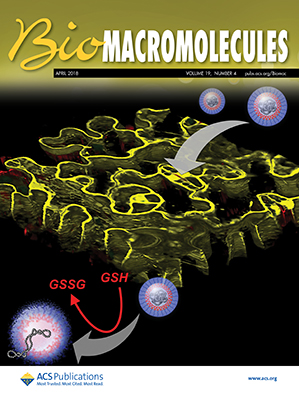Fabricating N‑Cadherin Mimetic Peptide-Based Diverse Self-Assembled Hydrogels in the Presence of Biologically Relevant Cations
IF 5.5
2区 化学
Q1 BIOCHEMISTRY & MOLECULAR BIOLOGY
引用次数: 0
Abstract
N-cadherin, a crucial extracellular matrix protein, is crucial in mediating cellular interactions and promoting cell migration. Herein, we have attempted to create N-cadherin mimetic peptide (NcMP) hydrogel scaffolds by incorporating cations as the external stimulus to create a suitable interface for favorable cellular interactions. Inspired by the Hofmeister series, we selected four biologically significant cations, classified as kosmotropes and chaotropes, and varied their concentrations to investigate how increasing ionic strength affects the self-assembly of the NcMP. Interestingly, the incorporation of these ions greatly influenced the self-assembling propensity of the Fmoc-HAVDI hydrogel, which resulted in diverse structural and mechanical properties. Such diverse physical properties led to differential cellular responses. Thus, we were able to access diverse physical and biological properties in a single gelator molecule by simply changing the nature and concentration of the biologically relevant cations. We anticipate that these diverse hydrogel systems hold great potential in various biomedical applications.
- Download: Download high-res image (183KB)
- Download: Download full-size image
在生物相关阳离子存在下制备n -钙粘蛋白模拟肽基多种自组装水凝胶。
n -钙粘蛋白是一种重要的细胞外基质蛋白,在介导细胞相互作用和促进细胞迁移中起着至关重要的作用。在这里,我们试图通过将阳离子作为外部刺激来创建一个适合细胞相互作用的界面来创建n -钙粘蛋白模拟肽(NcMP)水凝胶支架。受Hofmeister系列的启发,我们选择了四种具有生物学意义的阳离子,将它们分类为宇宙型和混沌型,并改变它们的浓度,以研究离子强度的增加如何影响NcMP的自组装。有趣的是,这些离子的加入极大地影响了Fmoc-HAVDI水凝胶的自组装倾向,从而导致了不同的结构和力学性能。这些不同的物理性质导致了不同的细胞反应。因此,我们能够通过简单地改变生物相关阳离子的性质和浓度,在单个凝胶分子中获得多种物理和生物特性。我们预计这些不同的水凝胶体系在各种生物医学应用中具有巨大的潜力。
本文章由计算机程序翻译,如有差异,请以英文原文为准。
求助全文
约1分钟内获得全文
求助全文
来源期刊

Biomacromolecules
化学-高分子科学
CiteScore
10.60
自引率
4.80%
发文量
417
审稿时长
1.6 months
期刊介绍:
Biomacromolecules is a leading forum for the dissemination of cutting-edge research at the interface of polymer science and biology. Submissions to Biomacromolecules should contain strong elements of innovation in terms of macromolecular design, synthesis and characterization, or in the application of polymer materials to biology and medicine.
Topics covered by Biomacromolecules include, but are not exclusively limited to: sustainable polymers, polymers based on natural and renewable resources, degradable polymers, polymer conjugates, polymeric drugs, polymers in biocatalysis, biomacromolecular assembly, biomimetic polymers, polymer-biomineral hybrids, biomimetic-polymer processing, polymer recycling, bioactive polymer surfaces, original polymer design for biomedical applications such as immunotherapy, drug delivery, gene delivery, antimicrobial applications, diagnostic imaging and biosensing, polymers in tissue engineering and regenerative medicine, polymeric scaffolds and hydrogels for cell culture and delivery.
 求助内容:
求助内容: 应助结果提醒方式:
应助结果提醒方式:


